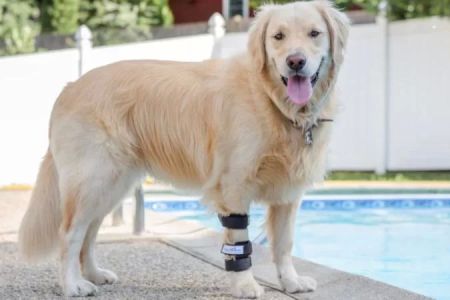Why Your Dog is Limping and Refusing to Walk: What You Need to Know
It was a sunny afternoon when I noticed something unusual with my dog, Max. He had been his usual playful self in the morning, but by mid-day, he started limping and refused to go for our usual walk. At first, I thought he might have just pulled a muscle or had a small injury. However, as the hours passed and Max continued to refuse his daily walks, I realized I needed to figure out what was going on. If your dog is limping and refusing to walk, you're probably experiencing some level of concern, too. Don't worry – you're not alone in this, and there are solutions that can help. Let’s dive into what might be causing your dog’s limping and how you can assist them through this time.
1. Understanding the Causes of Dog Limping
Limping is a common issue many dog owners face. However, it can be caused by a variety of things. Understanding the cause is key to determining how to help your dog recover. In my case, after a bit of investigation, I realized that Max had somehow hurt his paw during one of our outdoor runs. But that's just one potential reason. Here are some of the most common causes of limping in dogs:
Injury or Trauma
If your dog has recently been active or playing rough, it’s possible that they've sustained a sprain, strain, or even a fracture. Dogs love running, and sometimes a sudden movement or an accident can result in them injuring a limb. A traumatic injury might lead to swelling, bruising, and limping. If your dog is limping after a specific activity, check their paws for any cuts, thorns, or foreign objects like glass or sharp stones.
Arthritis and Joint Pain
As dogs get older, they can develop arthritis or other joint conditions, leading to chronic pain and limping. I’ve had friends whose senior dogs developed joint issues, and I’ve seen them struggle to walk as they once did. Arthritis can be a gradual problem, and it may not always be immediately obvious. If your dog limps after activity or seems to have difficulty standing up, joint pain could be the issue. In this case, managing the pain with medication or a vet-approved treatment plan can significantly improve their quality of life.
Infections and Abscesses
Infections or abscesses, especially in the paws, can also cause limping and reluctance to walk. Dogs explore their environment using their paws, which can lead to injuries or infections from bacteria or fungi. If there’s swelling, heat, or a foul odor coming from your dog’s paw, an infection could be the cause. Abscesses are common when a foreign object becomes lodged under the skin, and it can be quite painful for your dog.
Tick Bites and Other External Factors
While this was not the case with Max, tick bites can lead to limping if the tick has caused irritation or an infection. Other external factors like splinters or cuts from rough terrain can also lead to limping. Always check your dog’s paws and body for any signs of bites, scratches, or swelling, especially if you’ve been on a hike or a walk through wooded areas.
2. When Your Dog Refuses to Walk
If your dog is refusing to walk, it might be because they’re in pain or discomfort. Dogs have an incredible ability to tolerate pain to some extent, but when they’re not walking or moving normally, it’s a clear sign that something’s wrong. Here are some reasons your dog might refuse to walk:
Pain from Injury
As I experienced with Max, pain from a paw injury or other physical trauma can make your dog hesitant to walk. They might try to protect the injured area by refusing to put weight on it or simply by staying still. It's also possible that the pain from the injury is so intense that your dog prefers lying down rather than attempting to walk.
Fear or Anxiety
Sometimes, dogs refuse to walk due to fear or anxiety. For example, a negative experience during a walk, like running into an aggressive dog or encountering loud noises, could make your dog reluctant to leave the house. If your dog shows signs of fear, such as cowering or trembling, it might be best to help them overcome this by gradually reintroducing walking in a calm, controlled manner.
Illness or Health Conditions
If your dog refuses to walk and exhibits other symptoms such as lethargy, vomiting, or loss of appetite, it’s crucial to consider the possibility of an underlying health condition. Conditions like Lyme disease, hip dysplasia, or neurological issues can also make walking uncomfortable or even impossible. In such cases, it's important to consult a veterinarian to rule out any serious medical issues.
3. What to Do When Your Dog is Limping and Refusing to Walk
Dealing with a limping dog can be a stressful experience, especially if they’re refusing to walk altogether. However, there are steps you can take to help them recover and get back to their usual self:
Keep Them Rested
When Max first started limping, I made sure to keep him indoors and limited his activity. Rest is crucial for any dog with an injury or strain. Encourage your dog to rest and avoid forcing them to walk until the injury has healed. Too much activity can worsen the situation and lead to further injury.
Inspect for Injuries
Check your dog’s paws, legs, and body for any signs of injury. Look for swelling, cuts, or foreign objects lodged in their paw pads. If you find something, remove it carefully, and if the wound seems serious, apply pressure to stop any bleeding and take your dog to the vet. In Max’s case, he had a small cut on his paw that needed attention, which was the cause of his limping.
Consult a Veterinarian
If your dog continues to limp or refuses to walk despite rest, it's time to visit the vet. A professional can conduct an examination and provide a proper diagnosis. Whether it's arthritis, an injury, or a more serious health issue, a veterinarian will be able to guide you in the right direction to get your dog the care they need.
4. Home Remedies and Supportive Care
Depending on the diagnosis, there are a few home remedies and supportive treatments that can help your dog feel more comfortable. I gave Max a soft bed to rest on, kept him on a leash for short, gentle walks, and used ice packs to reduce swelling for a couple of days. Some pet owners find that supplements like glucosamine or anti-inflammatory medications help with joint pain and stiffness. However, always consult with your vet before administering any medications or supplements.
Remember, limping can be caused by a variety of issues, and while some may resolve on their own with rest, others require more intensive care. By keeping an eye on your dog’s behavior and symptoms, you can ensure they get the help they need, whether it’s through at-home remedies or veterinary care.











